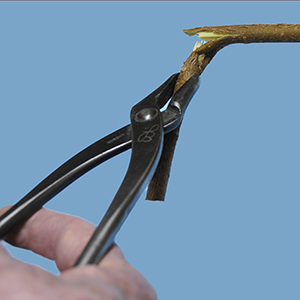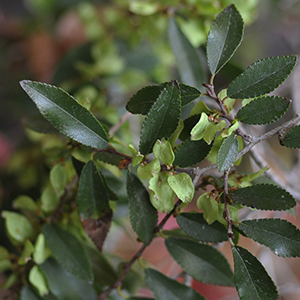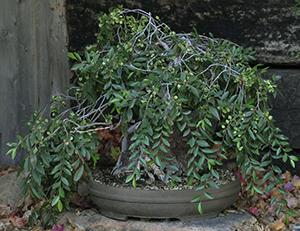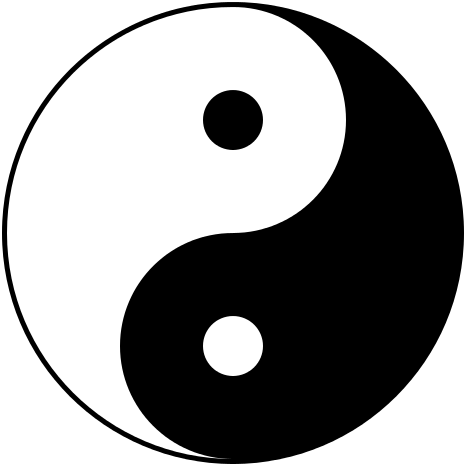Hints and Teasers
Bonsai Basics: Meanderings of an Old Man
By Lew Buller
Sun, Water, Flowers, Fertilizer, Soil, Stones, Pest and Disease
Hints and Teasers
Brain Teasers
by Lew Buller
Is this tree a gymnosperm? What species is it?
Hints and Teasers

Helpful Hints 1
by Lew Buller
Creating Jin, Creating Shari, Creating Root-over-Rock, Hollow centers in the root ball, Over-pot and Under-pot, The fingernail test, Trim deadwood
Creating Jin
You will get better results if you use jin pliers to create a jin on a live branch. Dead branches tend to break off squarely, not leaving the pointed tip that would result from a natural break. Do not create jin arbitrarily. It looks very strange to see a dead branch sticking out from an otherwise perfectly healthy green mass of foliage. You can use concave cutters to split the stub further. Or you can squeeze the end of the branch with the jin pliers, causing it to split and fray.
Hints and Teasers

Helpful Hints 2
by Lew Buller
Making fertilizer, Annealed copper wire, Wood blocks for planting angles, Making a turntable, Reusing soil
Making fertilizer
Cottonseed meal is an excellent organic fertilizer with a makeup of 5-2-1. Some advertised cottonseed meal has higher NPK numbers, possibly due to the addition of blood meal. A problem occurs when you put it directly on the soil around your plants. It breaks down with watering, becomes fine, and works its way down into the soil. The solution? Make your own cottonseed meal cakes that do not break down into fines.
Hints and Teasers

Helpful Hints 3
by Lew Buller
Use Brass not iron or steel, Testing for moisture, Making your own tools, Soil additives, Jin as a major design feature, Keep your tools clean and sanitary
In making tanuki, scions are sometimes fastened in place with small nails. The nails should be brass as it does not rust and discolor the same way as iron. This also applies to the use of screws. I like unusually shaped bonsai and so I fastened two trunks together using a brass screw. The cambium will heal over the opening I drilled for the screw and the two trunks should begin to self-graft as there is no possibility of movement away from one another.
The recommendation has been made that driving a nail into the trunk will provide iron to a tree showing signs of iron deficiency. Doesn’t work. Initial symptoms of iron deficiency are yellowing between leaf veins and browning at the edges of leaves. Chelated iron is immediately available to plants and can reverse leaf yellowing.
Hints and Teasers
Helpful Hints 4
by Lew Buller
Balance is important, Bare rooting your tree
Sooner or later a beginning bonsai enthusiast will hear someone say “Keep the top and the bottom of the tree in balance; if you cut off some of the foliage, cut off some of the roots.” Two questions arise: How much do you cut off of each? What happens if you get it wrong? Seldom do you get an answer to those questions.
The answer to the first question is that you never do more to either top or bottom than the other can support. The answer to the second is that if you’re lucky, the tree will make the necessary adjustments. The most important factor is the aftercare.
Hints and Teasers
Helpful Hints 5
by Lew Buller
Bonsai Myths, Approach Grafting, Five-gallon buckets, Tool box, Computer calendar
“Copper hardens due to sun and weather as it ages on the tree.” Not true. Copper hardens when it flexes; the grains in the copper become larger when it is flexed and therefore stiffer.
“Water drops on plants act like magnifying glasses and burn the foliage.” This myth was laid to rest by Professor Amy Liang who measured the amount of solar energy coming through a drop of water. As she reported in her book The Living Art of Bonsai, Sterling Publishing Company, New York, 1992, p. 182. “...its energy is only 0.2 calorie per minute. It is, therefore, incapable of burning leaves.” Her book is excellent, full of color photographs, color drawings, and black-and-white drawings for a total of 288 pages.





